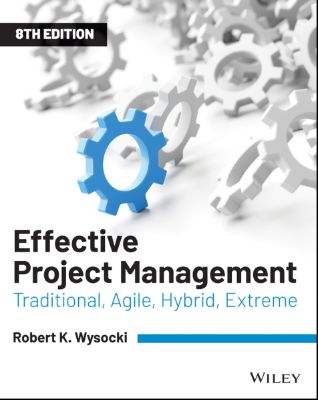Effective Project Management

Lýsing:
The popular guide to the project management body of knowledge, now fully updated Now in its seventh edition, this comprehensive guide to project management has long been considered the standard for both professionals and academics, with nearly 40,000 copies sold in the last three editions! Well-known expert Robert Wysocki has added four chapters of new content based on instructor feedback, enhancing the coverage of best-of-breed methods and tools for ensuring project management success.
With enriched case studies, accompanying exercises and solutions on the companion website, and PowerPoint slides for all figures and tables, the book is ideal for instructors and students as well as active project managers. Serves as a comprehensive guide to project management for both educators and project management professionals Updated to cover the new PMBOK® Sixth Edition Examines traditional, agile, and extreme project management techniques; the Enterprise Project Management Model; and Kanban and Scrumban methodologies Includes a companion website with exercises and solutions and well as PowerPoint slides for all the figures and tables used Written by well-known project management expert Robert Wysocki Effective Project Management, Eighth Edition remains the comprehensive resource for project management practitioners, instructors, and students.
Annað
- Höfundur: Robert K. Wysocki
- Útgáfa:8
- Útgáfudagur: 2019-04-08
- Hægt að prenta út 10 bls.
- Hægt að afrita 2 bls.
- Format:ePub
- ISBN 13: 9781119562733
- Print ISBN: 9781119562801
- ISBN 10: 1119562732
Efnisyfirlit
- Cover
- Preface
- Introduction
- Why I Wrote This Book
- How Is This Book Organized?
- Unique Value Propositions
- The Rationale for This Organization
- How to Use This Book
- Who Should Use This Book
- What's on the Website
- Putting It All Together
- EPM8e Logo
- Part I: Understanding the Project Management Landscape
- CHAPTER 1: What Is a Project?
- Defining a Project
- An Intuitive View of the Project Landscape
- Defining a Program
- Defining a Portfolio
- Understanding the Scope Triangle
- The Importance of Classifying Projects
- The Contemporary Project Environment
- Discussion Questions
- CHAPTER 2: What Is Project Management?
- Understanding the Fundamentals of Project Management
- Challenges to Effective Project Management
- Managing the Creeps
- What Are Requirements, Really?
- Introducing Project Management Life Cycles
- Choosing the Best‐Fit PMLC Model
- Discussion Questions
- CHAPTER 3: What Is Strategic Project Management?
- Definition of Strategic Project Management
- The Business Environment: A View from the Top
- Putting It All Together
- Discussion Questions
- CHAPTER 4: What Is a Collaborative Project Team?
- Overview
- The Complex Project Team
- Using the Co‐Manager Model
- Establishing Meaningful Client Involvement
- The Challenges to Meaningful Client Involvement
- Challenges to Attaining and Sustaining Meaningful Client Involvement
- Discussion Questions
- CHAPTER 5: What Are Project Management Process Groups?
- Overview of the 10 Project Management Knowledge Areas
- Overview of the Five Process Groups
- Mapping Knowledge Areas to Process Groups
- Discussion Questions
- CHAPTER 1: What Is a Project?
- Part II: Traditional Project Management
- CHAPTER 6: How to Scope a TPM Project
- Using Tools, Templates, and Processes to Scope a Project
- Managing Client Expectations
- Discussion Questions
- CHAPTER 7: How to Plan a TPM Project
- Using Tools, Templates, and Processes to Plan a Project
- The Importance of Planning
- Using Application Software Packages to Plan a Project
- Planning and Conducting Joint Project Planning Sessions
- Estimating
- Constructing the Project Network Diagram
- Writing an Effective Project Proposal
- Gaining Approval to Launch the Project
- Discussion Questions
- CHAPTER 8: How to Launch a TPM Project
- Using the Tools, Templates, and Processes to Launch a Project
- Recruiting the Project Team
- Developing a Team Deployment Strategy
- Conducting the Project Kick‐Off Meeting
- Establishing Team Operating Rules
- Managing Scope Changes
- Managing Team Communications
- Assigning Resources
- Resource Leveling Strategies
- Finalizing the Project Schedule
- Writing Work Packages
- Discussion Questions
- CHAPTER 9: How to Execute a TPM Project
- Using Tools, Templates, and Processes to Monitor and Control
- Establishing Your Progress Reporting System
- Applying Graphical Reporting Tools
- Managing the Scope Bank
- Building and Maintaining the Issues Log
- Managing Project Status Meetings
- Defining a Problem Escalation Strategy
- Gaining Approval to Close the Project
- Discussion Questions
- CHAPTER 10: How to Close a TPM Project
- Using Tools, Templates, and Processes to Close a TPM Project
- Writing and Maintaining Client Acceptance Procedures
- Discussion Questions
- CHAPTER 6: How to Scope a TPM Project
- Part III: Complex Project Management
- CHAPTER 11: Complexity and Uncertainty in the Project Landscape
- What Is Complex Project Management?
- What Is Lean Agile Project Management?
- Understanding the Complexity/Uncertainty Domain of Projects
- Discussion Questions
- CHAPTER 12: Agile Complex Project Management Models
- Iterative Project Management Life Cycle
- Adapting and Integrating the APM Toolkit
- Discussion Questions
- CHAPTER 13: Extreme Complex Project Management Models
- The Complex Project Landscape
- What Is Extreme Project Management?
- Using the Tools, Templates, and Processes for Maximum Extreme PMLC Model Effectiveness
- Using the Tools, Templates, and Processes for Maximum xPM and MPx Effectiveness
- Discussion Questions
- CHAPTER 14: Hybrid Project Management Framework
- What Is a Hybrid Project?
- What Is a Hybrid Project Manager?
- Background of the Effective Complex Project Management (ECPM) Framework
- Discussion Questions
- CHAPTER 15: Comparing TPM and CPM Models
- Linear PMLC Model
- Incremental PMLC Model
- Iterative PMLC Model
- Adaptive PMLC Model
- Extreme PMLC Model
- Challenges to Project Set‐up and Execution
- Discussion Questions
- CHAPTER 11: Complexity and Uncertainty in the Project Landscape
- APPENDIX A: Terms and Acronyms
- APPENDIX B: Case Study: Workforce and Business Development Center
- Hypothesis
- Synopsis
- The Need
- The Problem
- The Solution
- Linkages in the WBDC Model
- The Business Case for a WBDC
- Next Steps
- Putting It All Together
- APPENDIX C: Case Study: Pizza Delivered Quickly (PDQ)
- APPENDIX D: Cited References
- APPENDIX E: What's on the eiipbs.com Website?
- Course Master File
- A Note on the Answer File for the Discussion Questions
- Additional Chapters
- Index
- End User License Agreement
UM RAFBÆKUR Á HEIMKAUP.IS
Bókahillan þín er þitt svæði og þar eru bækurnar þínar geymdar. Þú kemst í bókahilluna þína hvar og hvenær sem er í tölvu eða snjalltæki. Einfalt og þægilegt!Rafbók til eignar
Rafbók til eignar þarf að hlaða niður á þau tæki sem þú vilt nota innan eins árs frá því bókin er keypt.
Þú kemst í bækurnar hvar sem er
Þú getur nálgast allar raf(skóla)bækurnar þínar á einu augabragði, hvar og hvenær sem er í bókahillunni þinni. Engin taska, enginn kyndill og ekkert vesen (hvað þá yfirvigt).
Auðvelt að fletta og leita
Þú getur flakkað milli síðna og kafla eins og þér hentar best og farið beint í ákveðna kafla úr efnisyfirlitinu. Í leitinni finnur þú orð, kafla eða síður í einum smelli.
Glósur og yfirstrikanir
Þú getur auðkennt textabrot með mismunandi litum og skrifað glósur að vild í rafbókina. Þú getur jafnvel séð glósur og yfirstrikanir hjá bekkjarsystkinum og kennara ef þeir leyfa það. Allt á einum stað.
Hvað viltu sjá? / Þú ræður hvernig síðan lítur út
Þú lagar síðuna að þínum þörfum. Stækkaðu eða minnkaðu myndir og texta með multi-level zoom til að sjá síðuna eins og þér hentar best í þínu námi.
Fleiri góðir kostir
- Þú getur prentað síður úr bókinni (innan þeirra marka sem útgefandinn setur)
- Möguleiki á tengingu við annað stafrænt og gagnvirkt efni, svo sem myndbönd eða spurningar úr efninu
- Auðvelt að afrita og líma efni/texta fyrir t.d. heimaverkefni eða ritgerðir
- Styður tækni sem hjálpar nemendum með sjón- eða heyrnarskerðingu
- Gerð : 208
- Höfundur : 12608
- Útgáfuár : 2019
- Leyfi : 379


